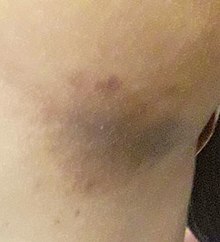Erythrasma
| Erythrasma | |
|---|---|
 | |
| Specialty | Dermatology |
| Causes | Corynebacterium minutissimum |
Erythrasma is a superficial
There are two types of erythrasma: generalized and
The presence of erythrasma is approximately 4% and is more likely to be found in the subtropical and tropical areas compared to the rest of the world. It is found more commonly in African Americans due to the darker skin and even though both sexes are affected, it is usually found more frequently in males for the thigh and leg regions.[2] A great contributor to this infection is a weakened immune system which comes with aging, therefore the elderly are more susceptible to this disease than the young; this does not mean the young cannot be affected. The epidemiology background of erythrasma remains partially unsolved.
Signs and symptoms
Lesions of erythrasma are initially pink, but progress quickly to become brown and scaly (as skin starts to shed), which are sharply distinguished. Erythrasmic patches are typically found in moist and
Cause
Erythrasma is caused by Corynebacterium minutissimum. This bacterium tends to thrive in mostly moist and warm environments. Great contributors are poor hygiene, obesity, hyperhidrosis (excessive sweating), aging, diabetes mellitus, and a poorly functioning immune system.[3] Only some of the causable factors can be modified to reduce risk. Hygiene can be improved, along with avoiding moist and warm environments.
Diagnosis
The differential diagnosis for erythrasma includes
Erythrasma is often mistakenly diagnosed as dermatophytic infection which is a fungal infection and not a bacterial infection. The difference here is that fungi are multicellular and eukaryotes while bacteria are single celled prokaryotes. This is vital to differentiate because the way they reproduce will indicate how the infection will spread throughout the human body.
Mechanism
Erythrasma manifests mostly in slightly webbed spaces between toes (or other body region skin folds like the thighs/groin area) in warm atmospheric regions, and is more prevalent in dark skinned humans. As a person ages, they are more susceptible to this infection. This bacterium is not only found in warm atmospheric regions, but also warm and sweaty parts of the human body. Corynebacterium minutissimum survives the best here due to the encouraged fungal growth in these regions and allows it to replicate. It is more prevalent in African Americans due to their skin pigmentation.
Treatment
Initial treatments for minor erythrasma can begin with keeping the area clean and dry and with antibacterial soaps. The next level is treated with
Below is a figure showing the different types and subtypes of therapies.| Oral | Topical |
|---|---|
| Erythromycin | Clindamycin |
| Clarithromycin | Whittfield's ointment |
| Tetracycline | Sodium fusidate ointment |
| Chloramphenicol | Antibacterial soaps |
There is no agreement on the best treatment for this disease. There are many limitations on these treatments such as more irritation, possible allergic reactions, and ulcerations.[3] These treatments are suitable for most ages, but for young children it should be monitored very closely.
Prognosis
Erythrasma has a good prognosis if it is discovered early and properly treated. In more severe cases, it can be an indicator for another disease such as
See also
- List of cutaneous conditions
- Athlete's foot
- Tinea pedis
- Wood's lamp
- Type 2 diabetes mellitus
References
- ^ a b "Erythrasma - American Osteopathic College of Dermatology (AOCD)". www.aocd.org. Retrieved 2017-11-06.
- ^ a b "Erythrasma". misc.medscape.com. Retrieved 2017-11-06.
- ^ S2CID 19741073.
- ISBN 978-1-4051-6169-5. Retrieved 14 November 2010.
- PMID 21771922.
- ISBN 978-0-7020-3485-5.
Further reading
- eMedicine
- Hamann K, Thorn P (1991). "Systemic or local treatment of erythrasma? A comparison between erythromycin tablets and Fucidin cream in general practice". Scand J Prim Health Care. 9 (1): 35–9. PMID 2041927.
